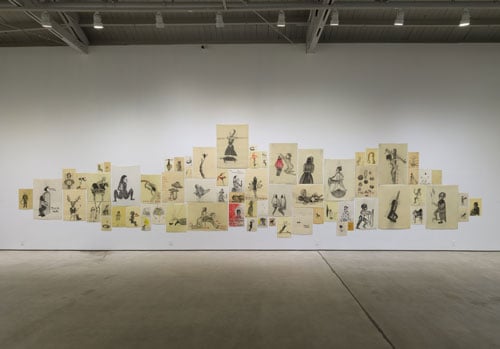MOTHER EARTH

Sandra Vásquez de la Horra, Yemanjá, 2025. (Jeff McLane /I CA LA)
One of my favorite paintings on the entire American continent is a strange canvas that resides at the Museo Nacional de Arte in La Paz, Bolivia. It’s a religious scene from the early 18th century titled La Virgen del Cerro that shows various figures from Catholic iconography surrounding a mountain that bears the head and hands of the Virgin Mary. It’s the ultimate syncretic piece, bringing together Catholic lore with Andean Indigenous traditions of venerating mountains — a Catholicized depiction of la Pachamama, the deity known in English as Mother Earth.
Pachamama’s power is pervasive in an engaging exhibition by Sandra Vásquez de la Horra now on view at the ICA LA in downtown. In meticulous drawings that range in scale from postcard-sized pieces to larger-than-life works, bodies merge with and emerge from landscapes. Women become mountains and bear circulatory systems made of delicate vines. It feels magical — more so because Vásquez de la Horra fully harnesses the power of drawing. The materials are simple — paper, graphite, and perhaps a little bit of paint. But the stories she conveys are rich and complex. I found myself returning more than once to her accordion-folded drawings of reclining women, which resemble the jagged profile of the Andes mountains. Think of them as a Virgen del Cerro for our age.
The Awake Volcanoes, as the exhibition is titled, was organized by curator Raphael Fonseca of the Denver Art Museum (where it originated last year) — marking Vásquez de la Horra’s first solo museum exhibition in the United States. Born in Chile in 1967 and based in Berlin since 1995, Vásquez de la Horra began to draw broader international attention in 2022, when she was included in the 59th Venice Biennale. There, she displayed a series of her drawings in a chapel-like structure — an installation, writes Fonseca in the catalog for The Awake Volcanoes, that “created a moment of stillness in the middle of the agitated Arsenale.”

El despertar de un volcán (The Awakening of a Volcano), 2019. (Jeff McLane /I CA LA)
The show at the ICA LA gathers dozens of drawings, prints, and paintings produced by the artist over four decades. This includes small, loose paintings of Chilean landscapes created in the early 1990s, along with works that followed in the latter part of the decade — like a series of surreal anatomical studies that seem to conflate and merge body and plant parts. A small, salon-style hang of these drawings at the ICA includes strange organic forms full of pistils, buds, and seeds. From some, emerge silhouettes of what appear to be human heads. In her world, humans are a part of nature, not apart from it.
Later drawings expand on these and other themes, adding words and phrases, including odd expressions and old sayings. Vásquez de la Horra grew up in Chile during the dictatorship of General Augusto Pinochet, which lasted from 1973 to 1990. In the world of literature, the novels and stories produced by authors who were children during the dictatorship are known as “la literatura de los hijos” — the literature of the children — works that express what a previous generation could not out of a fear of persecution. You could say that Vásquez de la Horra is working in the artistic equivalent of this tradition.
Another larger salon-style hang features dozens of drawings that riff on death and violence and the ways in which bodies (human and otherwise) are suppressed, but also find a way of resisting. Next to a cartoonish drawing of Pinochet, a man holds a flag next to the activist slogan, “El pueblo unido, jamás será vencido” — the people united, will never be defeated. In another, a woman lies next to a skeleton representing death. “Siempre acompañada” reads the adjacent text — always accompanied.

A salon-style hang of Vásquez de la Horra's drawings wrestle with violence and the body, among other topics. (Jeff McLane /I CA LA)
This is a quiet show — even when the scale of the artist’s works reaches larger-than-life proportions. But it sticks with you. I found myself chewing over some of its images for days afterwards. In these beguiling drawings, Vásquez de la Horra finds ways to link human bodies, ecological bodies, and the body politic in thoughtful and elegant ways.
🌋🌋🌋
Sandra Vásquez de la Horra, The Awake Volcanoes, is on view at ICA LA through March 1st. theicala.org.
.png?upscale=true&width=1200&upscale=true&name=email(600x74).png)